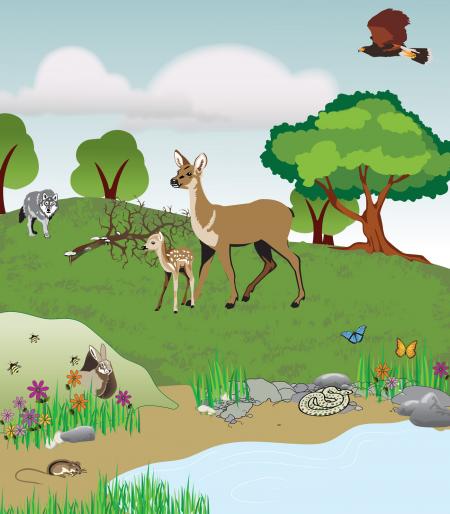Engage: Introduction to the Characteristics of Life
Explore Ia: What Do You See?
What a beautiful day in a field on the edge of a forest! Look carefully at the image. Make a list of everything you see in the picture in 3 minutes time. Ready? Set? Go!
Explore Ib: What Groups Do You See?
Now that you have your list, organize some of those objects into two categories using the animation below. Use your cursor to highlight the text in the blue boxes and type in the titles for your two categories. Click and drag the cards to place them under the column that best represents your two categories. Try to do this in less than 5 minutes!
Explain I: Debriefing
How did you sort your list of items from the picture? One way to sort the items is by classifying each as living or non-living, such as the items in the picture below.
Let's make sure we clarify the meaning of living and non-living.
Living: These are things that eat, move, breathe, excrete, grow, reproduce, and react to the world around them. To be classified as living, all of these characteristics must apply. Examples of living things are deer, fish, flowers, birds, trees, and grass.
Non-Living: These are things that do not have all of the above characteristics (eat, move, reproduce, etc.). Some of the characteristics may be true, but if they are not all true, then the object must be classified as a non-living thing. Examples of things that are non-living include sediments, water, sunlight, temperature, air, and rocks.
Let's check our own understanding by looking at a few examples in the video below.
Explore/Explain II: We All Have Needs
With a firm understanding of living and non-living things in our environment, let's look for connections. How do organisms in our sample ecosystem rely upon living and non-living elements in order to survive?
Let's discuss a sample organism to get you started.
A snake needs the following living elements in the environment to survive:
- Small animals to eat such as mice, moles, and chipmunks
- Eggs of various birds who nest along the shore of the lake
A snake needs the following non-living elements in the environment to survive:
- Rocks to provide shelter and warmth
- Thermal energy from the Sun
- An acceptable range of temperatures
- Clean air to breathe
- Clean water to drink
- Space to live in and raise their young
All of these living and non-living elements help the snake live and survive in its ecosystem.
Now it's your turn! How many more examples can you find? If you need some help deciding, download the Impact on Organisms' Survival document in the "Related Items" section below.
Elaborate: Impact on White-Tailed Deer
There is an interesting situation occurring with the white-tailed deer population in the state of Kentucky. Think about the following question:
- What living and non-living elements are affecting the white-tailed deer population? In this case, what non-living and living elements are possibly playing a role in the decreasing number of deer?
Consider the question above and develop a response as you read an article and view a short video segment about the situation in Kentucky. Use the Deer Population Decline Article and Elaborate Recording Sheet in the "Related Items" section below.



